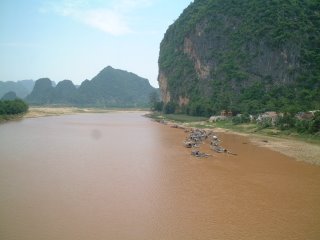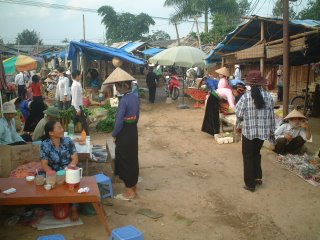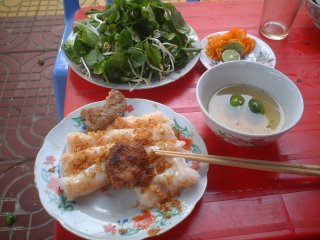On the Trail of Ho Chi Minh















Sam Son Beach, outside Thanh Hoa
I'm sitting in the armpit of Vietnam, a beach resort of such tremendous grottiness and sleaze that it makes Pattaya look attractive. The water, a muddy brown colour, is so full of floating garbage that it makes it look like the local dump got flooded. At least it distracts you from the dirty brown scum of foam at the waterline, the origins of which I don't want to think about. I am the only whitey in town (big surprise there! Who in their right mind would come here?), but it's packed with groups of Vietnamese men in town to drink and whore in the multitudinous "massage parlours". There are no commercial transactions here that don't qualify as ripoffs, or attempted ripoffs. I will be happy indeed to roll out of here tomorrow.
So the last time I updated the blog, I was a day out of Sapa. I rode 2 more long, hard, hilly days to get to Dien Bien Phu, the place where the might of the French army proved no match for the preparation, tenacity and artillery of the Viet Minh guerrillas in 1954. The riding to get to DBP was fun, not to mention unexpected; my "map" again provided little clue as to what was coming up. On the first day, I climbed a very minor hill and then flew downhill for more than 20 km to the bottom of a valley, passing a very taciturn Dutch couple on bicycles coming the other way. I spent the rest of the day undulating up and down the walls of a river gorge on quite a peaceful, pretty road, surrounded by the sound of singing birds. It was the last really hot day I had, reaching the customary 40 degrees around noon. That evening, in old Lai Chau (they've renamed several towns in the area, so that I wrote my last post from new Lai Chau, and then rode all day to get to old Lai Chau), it bucketed down rain with tremendous lightning, cooling down the air temperature for the next week. I sheltered in a restaurant with a Swiss woman and her motorcycle driver. They had crashed earlier in the day when a truck ran them off the road, and the driver had cut his foot badly. He was a fount of local knowledge and great fun to talk to.
The next day was a big day for climbing, with my altimeter showing 2150 vertical metres by the time I got to Dien Bien Phu. I had three major passes and lots of little climbs. Luckily it wasn't too hot. I entered the area inhabited by the Thai minority, the best-looking tribe in Vietnam, at least as far as the women go. They all sport big buns or beehive hairdos that tower over their heads, and when they put on a woven headdress or a conical hat, they look like some of Dan Ackroyd's Coneheads. When they have their heads uncovered, they have a small disk on the bun of hair that gives them the look of Shiva. Faces like the apsaras at Angkor Wat, long black high-waisted skirts and surprisingly tall physiques complete an alluring look. I'm not sure whether the Thai here are related to the Thai of Thailand, but I would imagine they're the same.
I rolled into the flat agricultural plain of Dien Bien Phu under clear late afternoon skies. Everyone was busy harvesting rice, and it looked very pretty and peaceful, a world away from how it had looked 52 years ago. The French, trying to pin down a marauding Viet Minh army that was rampaging through Laos (the border is only 20 km from DBP), flew thousands of troops into DBP to cut off their supply lines. This was a very, very foolish move, as the French found themselves surrounded, outnumbered 5 to 1 and pinned down by artillery fire and anti-aircraft guns that the Viet Minh had lugged in through the jungles, over some of the same passes I cycled over. When the battle began, the French artillery chief, who had told the commanding colonel that the Viet Minh wouldn't have any artillery, realized his error, shouted "It's all my fault" and threw himself onto a grenade to erase his shame. The rest of the French held out for 57 days before surrendering. The French lost 3000 dead and 12,000 taken prisoner; the Viet Minh lost 25,000 troops but won the battle and, soon after, the war, as the French government gave up on holding Indochina. As the commanding general Vo Nguyen Giap said to a French official at negotiations a few years earlier "You can kill 10 of my soldiers for every one of yours that we kill. But at those odds, we will still win and you will still lose." Words that the Americans might have taken to heart and saved themselves, and Southeast Asia, two more decades of misery and war. I toured some of the battlefield memorials, including the French memorial stone and the Vietnamese cemetery. I always feel drawn towards war cemeteries, perhaps since if I had been born at the wrong time, I could easily have been drafted and ended up fertilizing a Vietnamese ricefield myself. I'm also generally a fan of the invaded underdog in situations like this: the Chechens, the Iraqis, the Afghans, the Vietnamese, the people of Darfur. Too bad they don't win more often.
I rolled out of Dien Bien Phu the next day feeling tired; early mornings and long days of climbing were catching up to me. Luckily the day was relatively short and easy, with only one real pass to climb. On the way, I rolled down a river and saw dozens of villagers waist-deep in water, panning for gold. I wonder if they find enough to justify the effort.
The steepest pass of the trip awaited me the next morning; it averaged 8 percent grade for 9 kilometres, and was really quite vertical on its switchbacks. Near the top I had a long chat with an English motorcyclist on his way to Mongolia, and then, coming down the shredded wreck of a road on the other side of the pass, I met a group of 6 Norwegian cyclists. We gabbed for a while, and they gave me photocopied guidebook pages and maps that made the next few days less of a mystery. No sooner had I left them, but I met a Dutch guy on a bike. Strange that after meeting so few other tourists, I ran into so many inside an hour. I slept that night in Son La, a bustling provincial capital. In a restaurant I sat next to a group of Meong women and kids who were in town for the market. Looking at them, you could see that for them, life was a struggle; they looked poor and down on their luck, unlike the Hmong in Sapa who make a good living selling stuff to tourists. This may have to do with the tremendous population pressures on the land; most hills are cultivated right to the top, with attendant erosion and landslide problems. These people might well have been farming some pretty marginal land.
I thought about this the next day as I rolled along a new, wide, smooth, gently-sloped road. It had been so long since I'd been on such a good road that I absolutely flew, and I had time to contemplate things like the Ecological Footprint calculation that I had my friends do recently. For a subsistence farmer, it's pretty obvious what your ecological footprint is; it's the area of land you cultivate. I'm sure that the local farmers have a much lower ecological footprint than I, an overconsuming Westerner, do. but there are so many farmers in such a small area that it overloads the environment. If the local farmers keep having large families, most of those kids will have no alternative but to flock to the cities since there will be no land left for them to farm. Quite a contrast to Canada, where we each use lots of the planet's resources, but where we have, by dumb luck within our borders, so much land and so many resources to use that we still have lots of room per person.
Musing about stuff like this, I covered 118 km and stayed in a town called Moc Chau, a higgledy-piggledy arrangement of houses around limestone pinnacles. I stayed in the Lonely Planet-recommended hotel, and regretted it, as it was one of the noisiest nights of the trip. Lots of prostitutes, lots of customers, high heels stomping around at all hours, karaoke echoing through the hallways, somebody hauling a wheeled suitcase out at 3 am, and, the final insult, loudspeakers broadcasting 100 decibels of exercise tapes at 4:50 am. I really don't know how the Vietnamese get any sleep at all, unless they have hearing damage that blocks it all out.
Two days ago I left Moc Chau, had one more big climb and then coasted downhill into the lowlands. I turned south on the Ho Chi Minh Highway, supposedly following the route of one of the Ho Chi Minh trails of the war, and fought my way 50 km south to Quan Trung, a surprisingly pleasant little town tucked among the limestone cliffs lining the Song Na river. Along the way I passed literally millions of white butterflies, and a bamboo forest which was being processed into chopsticks.
Yesterday was a red-letter day for riding, as the valley opened up and I flew along on flat roads, past rice harvesting and clouds of schoolkids on bicycles, through an ancient royal citadel and on into Thanh Hoa, a decent-sized city, and another 16 km into this dump. The riding was so easy that I did 155 km, despite long breaks for beer and food and ice cream spaced throughout the day. The only real downer was being spat on (right in my face) by a motorcyclist coming the other way; too bad I didn't have time to lob a pebble into his path! I did decide to take a day off, though, my first lazy day in 2 weeks, to give my legs a rest. I just wish it was in a more salubrious town.
The plan now is to stick to the coast, more or less, and head down into the tourist sites of the central coast and down to Saigon. I hope that the next lowland towns I come to have fewer lowlifes than here in Sam Son.
I'm wading through Herodotus right now, loving all the anecdotes and diversions. The following is my current favourite quote. So deadpan, it might come from a well-written Lonely Planet.
"Aside from the fact that they prostitute their daughters, the way of life of the Lydians is very similar to our own." Not the sort of sentence that you read every day.
Until next time, tam biet!
Graydon

0 Comments:
Post a Comment
<< Home